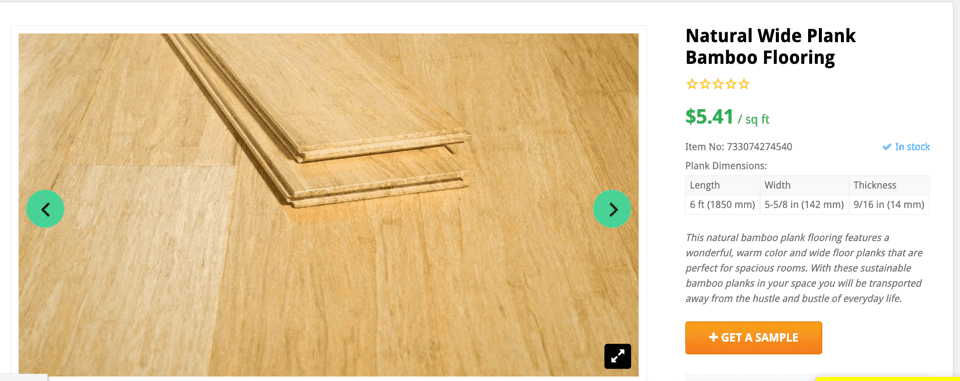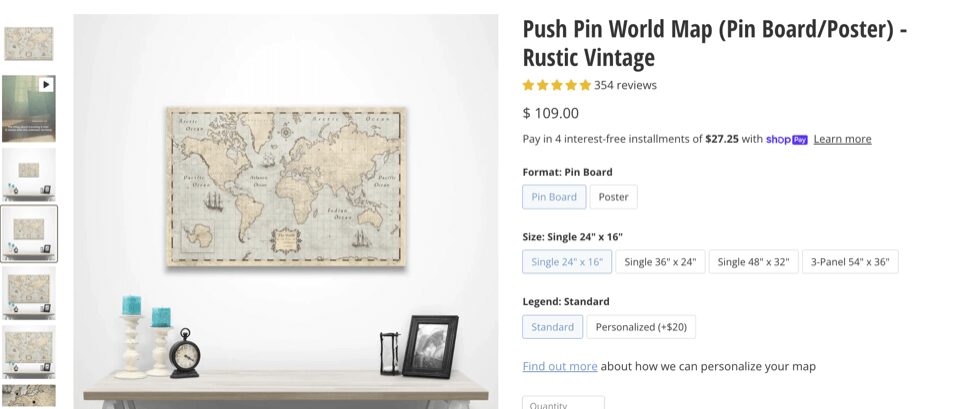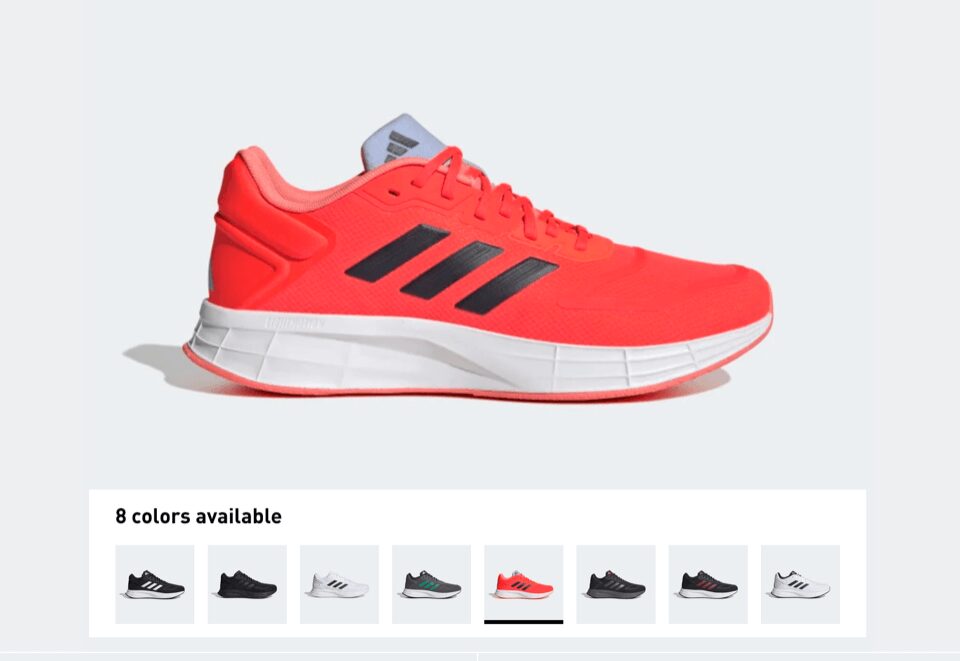
You’re doing everything you can to get people on your site: social media campaigns, email bursts, Google Ads, and more. Yet though analytics show your efforts are working, the dismal sales numbers tell a different story. What gives?
The truth is that increasing web traffic is only the first part of the process. The real work is guiding a visitor from the product page all the way to checkout.
Each year it gets trickier as competition increases and shoppers become more web savvy — the conversion rate for all ecommerce markets decreased from 2.38% to 2.10% from November 2021 to November 2022, meaning for every 100 page visitors, fewer than three will buy your product.
To beat that average, you need compelling product pages.
Fortunately, it’s not as hard as it sounds. There are proven product page optimization strategies that take the guesswork and complexity out of creating pages that drive more sales.
Table of Contents
- 1 How Can You Optimize Your Product Pages?
- 1.1 1. Ensure Quick Loading Times
- 1.2 2. Use Engaging Product Titles
- 1.3 3. Support Your Titles With Effective Descriptions
- 1.4 4. Add High-Quality Product Photos
- 1.5 5. Include Product Videos
- 1.6 6. Clear Call-to-Actions (CTAs)
- 1.7 7. Include Information That Will Influence Customers’ Purchase Decisions
- 1.8 8. Show and Link to Similar Products
- 1.9 9. Entice Customers With Aspirational Content
- 1.10 10. Use Social Proof
- 2 Optimize for Success
How Can You Optimize Your Product Pages?
No matter what you’re selling, great product pages share the same core features. These ten tips can work on any ecommerce website from shoes to toys to vitamin supplements. It all comes down to user experience.
1. Ensure Quick Loading Times
Your product pages may attract a lot of traffic through SEO, but they could be losing just as much if they are too frustrating to navigate.
Your page should provide an optimal viewing experience, and that starts with speedy loading. Pages that load within two seconds have a 9% bounce rate, while five-second load times lead to a 38% bounce rate, and studies show that online shoppers are even more impatient than someone just browsing for entertainment or information.
Get your page to load faster by compressing large image and video files, or consider using a content delivery network (CDN) if your content is data-heavy or the website receives a lot of traffic.
Once loaded, ensure the layout is responsive on any device. Your customers should enjoy viewing the page on their mobile phones just as much as they would on a computer screen — with minimum scrolling, zooming in, and panning.
Not to say you shouldn’t include zoom-in and out features. Allowing your customers to take a closer look at the finer details is an important aspect of product page optimization. Just make sure that these features do not slow the page.
2. Use Engaging Product Titles
A product title can directly impact customer engagement and conversion for multiple reasons: It lets a buyer know they are in the right place, provides first impressions of the product, and enables search engines to find your product, thereby increasing your product’s visibility. It goes without saying that they should be both informative and engaging.
Here’s how to write product page titles that fulfill both SEO and user expectations:
- Keep it brief. Users quickly scan search results to find the keywords they’re looking for and ignore lengthy product names. The ideal length is between 50-75 characters.
- Use leading keywords. Keywords optimize product pages for search engines by matching your product with search queries. Put the most important keywords at the beginning of your title to catch the scanning eye.
- Add modifiers. Make it easier for your potential customer to find what they are looking for by including specifics such as brand, color, material, size, and other significant details.
- Make sure you can walk the talk. There’s nothing wrong with emphasizing your wins or credentials, but don’t say “the best” or “voted number one” unless you have some data to back that up. Avoid overusing “exclusive” and “one-time offer” as these can often come across as inauthentic or misleading.
This bamboo flooring product page from Ambient checks all the boxes: concise, search-engine optimized, and descriptive without seeming disingenuous.

Pay attention to products with a low click-through rate. Chances are several could benefit from optimized product page titles.
3. Support Your Titles With Effective Descriptions
You’ve captured your page visitor’s attention with the title, now it’s time to convince them of your product.
The first step in writing an effective description is to understand your audience and what causes their buyer hesitation. Are they unsure how to use your product? Or maybe they are looking for specific features? This data will inform what to include and highlight. Remember, the description is there to answer your buyer’s questions.
Your core audience should also inform your messaging and tone: What kind of words do they use? How do you speak to them face-to-face? How do they interact with your social media and other channels? Incorporate these words and phrases into your product description to foster familiarity and make your message more memorable.
Here’s a tip: This does not apply to product page optimization alone. A relatable brand identity leads to more effective marketing efforts.
4. Add High-Quality Product Photos
Visuals are a vital part of a product page, if not the most important.
They help in the decision-making process by giving page visitors a more detailed look at the product — its design, scale, shape, use, quality, and unique selling points.
They are also an opportunity for brands to communicate their identity through mood and lighting, image scenes, and more.
Use high-definition visuals to ensure the visitor does not miss these details. Your potential customer should be able to closely inspect your product on any screen resolution because, as mentioned before, users like to zoom in on images. A high-quality image should not affect your page’s loading speed.
Satisfying your page visitor’s curiosity is the ultimate goal of using visuals to optimize your product pages, so consider any detail or different perspective they may want to see and provide the answers through great photos.
This example from Conquest Maps stages the product so customers have an accurate sense of its size and can imagine how to display it. The sidebar allows for closer inspection of the product’s details and features.

5. Include Product Videos
“I don’t want a video that shows me what the product looks like and how to use it,” said no one, ever. Customers appreciate well-produced, engaging, and straightforward videos that can help them make a decision.
Leveraged correctly, videos for product page optimization are a powerful tool. In one study by Wyzol, a video production platform, 89% of people said watching a video has convinced them to buy a product or service. And if you were wondering where to start, 53% of businesses said video marketing has helped them reduce support queries, making a case for explainer videos and product showcases.
Like with photos, create your videos from the perspective of the customer’s needs, not what you think are your product’s best features.
Place videos alongside your images to help users find them, differentiating them from the other visuals with a “play” icon. It also doesn’t hurt to repeat them in other sections of the product page to target visitors interested enough to keep scrolling.
The travel outfitter Away effectively uses videos to elegantly demonstrate new products.

6. Clear Call-to-Actions (CTAs)
A product page without a call to action is like a door without a handle. The same goes for a CTA that does not align with the page purpose or messaging: buy this product.
CTAs are everywhere online. However, shoppers have grown accustomed to specific prompts on ecommerce stores over the years. It is best practice to stick with these standard CTAs to avoid confusing the customer. Simple, straightforward phrases like “Buy Now,” “Submit Order,” or “Add to Cart” work perfectly fine. Trying something too creative may end up confusing site users.
Luckily you have a little more wiggle room with the button’s appearance and color. Whatever you choose, make sure it stands out from the surrounding content and is immediately visible to visitors when they first land on the page. Check also that your CTA buttons are optimized on your product pages no matter what device you view them on.
7. Include Information That Will Influence Customers’ Purchase Decisions
Setting the stage for your customers to click your CTA button is all about providing information that makes them eager to take the next step.
However, many people solely rely on product descriptions for this, not realizing there is plenty of real estate right before and after the CTA button where you can communicate convincing information. This helps to capture the interest of visitors who aren’t interested enough to read the descriptions.
Examples of information you can use for your product page optimization include:
- Discounts: Is your product on sale? Make it evident to the customer how much they are saving by showing the before and after prices.
- Promo codes: Do not just display your promo codes on your ecommerce landing page or headers. Remind your visitor that they could pay less by showing the promo information alongside the price. Create a sense of urgency by telling them when the offer ends.
- Free delivery: Free delivery is the leading deciding factor in people purchasing a product online, with 53% of online shoppers sharing this view. Let your customers know if you offer free shipping or how much they should order to qualify.
- Buy Now Pay Later (BNPL): BNPL has grown exponentially in the ecommerce world as more shoppers expect it as a payment option. Making it explicitly clear that you offer BNPL can increase your store’s conversion rate by up to 30%.
8. Show and Link to Similar Products
Like with photos, showing the customer product variants or other similar products is a great way to offer a different perspective on your search-optimized product pages.
Additionally, a “You May Also Like” section provides an upselling or cross-selling opportunity while improving your customer’s browsing experience. You already know what your page visitors like or are looking for, so why not save them from having to scroll through endless products to find something else along the same lines?

In the photo above, the Adidas online store provides color variants as a product page optimization tactic to facilitate easy comparison. Plus, each picture links to its individual page where customers can view more details and add the shoe to the cart.
9. Entice Customers With Aspirational Content
Emotion is a powerful way to connect with your customer and aspirational content on your product pages is one of the best ways to tap into it. By showing them how your product helps them reach their goals or vision, you inspire potential customers to take action.
A simple strategy is to optimize your product page with content that helps them imagine themselves using it or how it can solve a problem they face. However, you can go further by romanticizing the context to increase their yearning.
For example, sportswear brands commonly use models with perfect bodies that are unattainable for the ordinary wearer. Nonetheless, a buyer imagines themselves working out to look like the model and associates the brand as a tool to help them achieve their goal.
Be careful not to use concepts that feel out of reach. While consumers want to aspire to something or to be like someone, a balance between aspirational and relatable content is necessary to keep them engaged and coming back.
10. Use Social Proof
This may be last on the list, but it should be part of any product page optimization effort. Social proof is one of the most effective ways to drive sales conversions.
The concept involves using previous customers to do the selling by giving their opinion on your products and services. Most customers trust word of mouth over a business’s claims, thus the experience of a person just like them carries a lot of weight.
We mean a lot: TrustPulse found that almost 100% of consumers consider customer reviews before deciding to buy a product online, while another study discovered that consumers are 270% more likely to purchase a product with five reviews than those with no reviews at all.
There are many types of social proof, but the most common for ecommerce are testimonials, case studies, and reviews. Do not include only positive reviews. Studies show that customers trust businesses that display their negative reviews more because it shows they have nothing to hide.
Optimize for Success
While efforts to drive traffic to your online store are important, the product page is your last chance to convince visitors to buy from you. That’s why product page optimization is directly linked to business success.
See how Coalition Technologies’ optimization strategies helped a luxury brand’s monthly revenue grow from $221,000 to $366,000 in just 10 months.
Don’t know where to start? Our team can help you achieve similar results no matter your industry or size of business. Contact us today to get a free strategy review on your ecommerce site and product pages.


